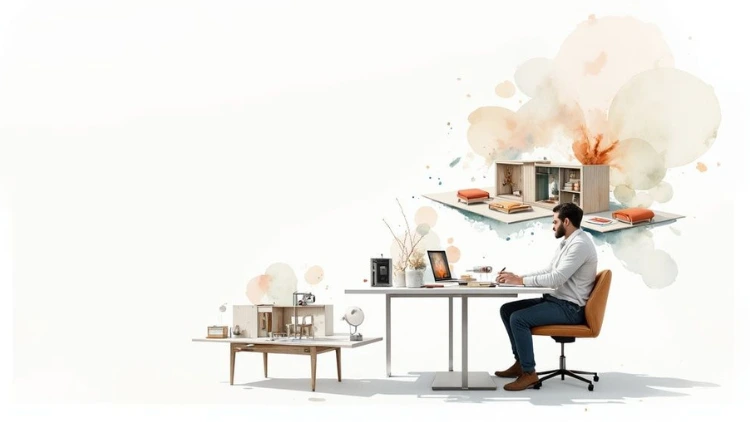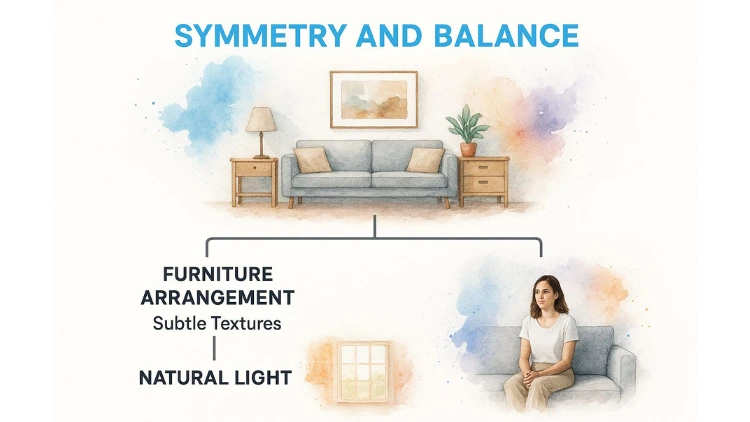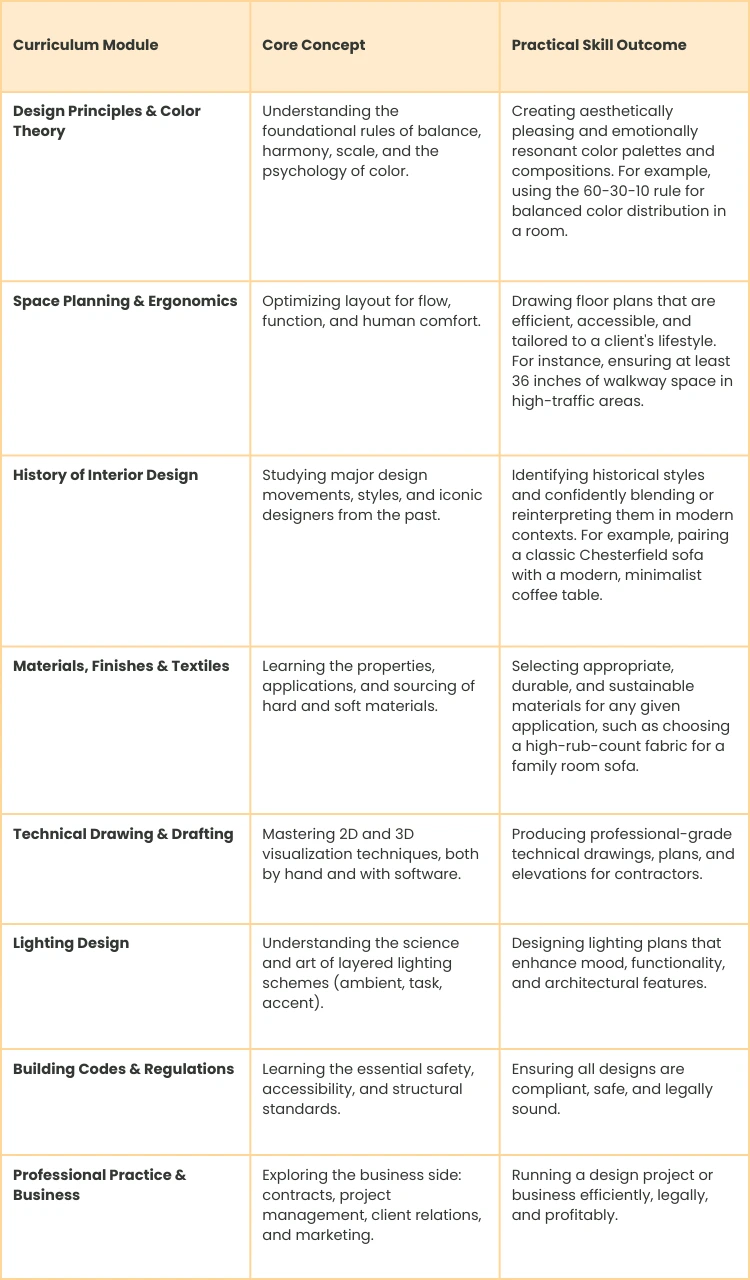Your Guide to the Best Interior Design Course Options

So, you're thinking about taking an interior design course. It's a fantastic move, but it's important to understand what you're really signing up for. This isn't just about picking out pretty pillows and paint colors; it's a deep dive into turning a passion for beautiful spaces into a full-fledged professional career.
A good course gives you the technical knowledge and creative framework to design environments that don't just look good, but also work brilliantly for the people who use them. An actionable insight to keep in mind is that professional design is about solving problems for clients, not just applying your personal taste.
Jump To Section

Earn As You Learn
Earn 25% commission when your network purchase Uplyrn courses or subscribe to our annual membership. It’s the best thing ever. Next to learning,
of course.
What an Interior Design Course Really Teaches You
We like to think of a formal interior design education as training you to be a "space psychologist." You learn both the art and the science behind how a room can influence mood, behavior, and overall well-being. It’s the critical step that elevates your natural creative flair from a hobby into a credible, client-ready profession.
Instead of just guessing what works, a structured program hands you a reliable toolkit for solving real-world design puzzles. You'll move beyond simply choosing a paint color you like and start using color theory to intentionally create a specific mood. For example, instead of just picking "green" for a home office, you'd select a specific shade like sage green to promote focus and reduce eye strain, a practical application of color psychology.
From Passion Project to Professional Practice
This educational path is all about building a solid foundation of practical, repeatable skills. A great program teaches you to look past the surface-level decor and truly understand the bones of a well-designed space. This means mastering concepts like:
- Functionality over Fashion: You'll learn to prioritize how a space is actually used. Designing a kitchen for a passionate home chef, for instance, requires a completely different layout and material selection than one for someone who mostly orders takeout. A practical example would be specifying durable, non-porous quartz countertops and a professional-grade ventilation hood for the chef, while the takeout client might prefer a more aesthetic but less durable marble island for entertaining.
- Safety and Compliance: It’s not the most glamorous part, but it's essential. You'll get familiar with building codes, accessibility standards, and safety regulations. An actionable insight here is to always check local codes for minimum hallway widths or electrical outlet spacing before finalizing a floor plan to avoid costly revisions later.
- Client Communication: This is a huge one. You'll develop the skills to listen to a client's fuzzy, half-formed ideas and translate them into a concrete, actionable design plan they'll love. For instance, if a client says they want a "cozy" living room, you'll learn to ask follow-up questions to determine if "cozy" means plush textiles and warm colors, or dimmable lighting and a space for family games.
This kind of structured learning is becoming more and more valued. The global market for interior design education is expected to hit roughly $6.0 billion by 2033, which is a huge leap from its $1.5 billion valuation back in 2020. That number tells a story: there's a growing global demand for professionals with specialized knowledge in crafting interior spaces.
Understanding Your Role in the Industry
Any comprehensive interior design course will also give you a map of the professional landscape. It will clarify the distinct but often overlapping roles of architects and interior designers, teaching you how to collaborate effectively on a project team.
At its heart, formal design education gives you a repeatable process. It provides the confidence to tackle any project—from a tiny studio apartment to a massive commercial office—because you have a proven method for analysis, problem-solving, and execution.
Ultimately, this training is about mastering a discipline. Many of the core principles you'll learn—like balance, rhythm, and scale—are universal to visual arts. In fact, you might find it interesting to see how they parallel the essential elements of graphic design and other forms of visual communication.
What You'll Actually Learn Inside the Curriculum
Think of an interior design course as your creative apprenticeship. Every module adds a new tool to your belt, and mastering how to use them together is what separates a keen amateur from a true professional. The best programs are structured to build your expertise from the ground up, starting with core principles before moving into complex, real-world projects.
At the heart of it all is Space Planning. This is the grammar of design. It’s not just about deciding where the furniture goes; it’s about choreographing movement and creating a natural, intuitive flow through a room. You learn to make every square inch count.
A classic early project might be redesigning a cramped 500-square-foot studio apartment. A practical example would be to use a platform bed with built-in storage to eliminate the need for a separate dresser, and a drop-leaf dining table that can be pushed against the wall when not in use. These are actionable solutions for maximizing small spaces.
Mastering Materials and Light
From there, you’ll dive into Materials and Finishes. This is where things get tactile. You'll learn the practical pros and cons of everything from flooring and textiles to countertops and paint. The goal is to make smart, durable choices that fit a client's lifestyle and their budget.
For instance, you'll learn the real-world difference between choosing quartz or marble for a kitchen counter. Marble is stunning, with unique natural veining, but it's also porous and stains easily—a terrible choice for a family with young kids. Quartz, an engineered stone, gives you a similar high-end look but is non-porous and tough as nails. This is a practical choice that directly impacts a client’s daily life.
Many courses also zoom in on specific applications of space planning, covering essential kitchen design principles that balance the heavy demands of function with beautiful form in the heart of the home.
Lighting Principles is another area where you'll have a major "aha!" moment. You'll quickly see that lighting isn't just an accessory; it’s a powerful tool for sculpting a room, setting a mood, and highlighting what matters.
- Ambient Lighting: This is your base layer of light, the general illumination from a ceiling fixture. A practical tip is to install a dimmer switch on your main overhead lights; this is a cheap and easy way to dramatically change a room's mood.
- Task Lighting: This is targeted, functional light for specific activities, like under-cabinet LEDs for chopping vegetables or a perfect reading lamp next to a comfy chair.
- Accent Lighting: This is the fun stuff—the dramatic light that draws the eye to a piece of art, a textured wall, or a unique architectural feature. For example, using an uplight behind a large plant creates dramatic shadows and adds depth to a corner.\
Learning to layer these three types is what creates depth and character. It’s the secret sauce that transforms a flat, boring room into a space that feels dynamic and alive.
This visual shows how these skills stack on top of one another, from the fundamental concepts to professional execution.
As you can see, a solid grasp of fundamentals like color theory and form is the bedrock for developing advanced skills like project management and client relations.

Core Modules in a Typical Interior Design Course
To give you a clearer picture, here’s a breakdown of the core modules you’ll find in most reputable interior design programs.
This table outlines the essential subjects covered in most comprehensive interior design programs and the practical skills gained from each.
These modules work together to give you a complete, well-rounded skill set, preparing you for the diverse challenges you'll face in the field.

Bringing Ideas to Life
Finally, any great course will teach you how to sell your vision. You'll get your hands on industry-standard software like AutoCAD and SketchUp to master technical skills like Drafting and 3D Modeling. These are the tools that let you create precise floor plans and photorealistic renderings that show a client exactly what they're getting.
The ability to translate an abstract idea into a tangible, visual plan is perhaps the most valuable skill you will learn. It’s what builds client trust and brings your creative concepts into reality.
This often starts with a much simpler, but equally powerful, tool. You'll find that a key first step in any project is to make an interior design mood board to nail down the aesthetic direction. It’s this combination of hands-on creativity and technical know-how, all backed by a solid understanding of design history and theory, that forms the powerful education you need to launch a successful career.
Choosing Your Learning Path: Online vs. In-Person
One of the first big decisions you'll make is where you’ll actually learn: online from the comfort of your home, or in a traditional, in-person classroom. This isn't just about convenience; it’s about figuring out which environment will help you thrive.
Think of it this way: both paths lead to the same destination—a career in interior design—but the journey is completely different. The right choice really comes down to how you learn best, what your daily life looks like, and what you want to get out of the experience.
The Case for Online Interior Design Courses
Let’s be clear: modern online learning is a world away from the old days of just downloading PDFs. The best programs today are incredibly interactive, using sophisticated digital tools to bring design concepts to life. This makes an online course a fantastic option, especially if you're a self-starter or looking to switch careers without quitting your day job.
Imagine learning space planning not by staring at a 2D floor plan, but by taking a virtual reality (VR) walkthrough of your own design. You could literally "stand" in the living room you just created, getting a gut feeling for the scale and flow that a flat drawing could never give you. That's how technology is making online learning more hands-on than ever.
The biggest draw, of course, is flexibility. You can study after the kids are in bed or squeeze in a lecture on your lunch break. An actionable insight for online learners is to schedule dedicated "studio time" in your calendar each week, just as you would for an in-person class, to maintain momentum and avoid falling behind.
The Power of the In-Person Experience
On the other hand, there’s a special kind of magic that happens in a physical design studio. The creative buzz you get from working side-by-side with your classmates is something that’s tough to replicate through a screen.
A major plus is the direct access to materials. You can run your hand across a velvet swatch, feel the heft of a quartz countertop sample, or see how natural light plays on different wood finishes. This tactile experience—actually touching and feeling the materials you'll be working with—is a cornerstone of interior design. A practical example is comparing three different "white" paint swatches on a physical wall to see how they change color throughout the day—an experience that's hard to simulate accurately on a screen.
The spontaneous brainstorming and mentorship in a studio are priceless. Overhearing a classmate’s brilliant idea or getting an instructor’s immediate, shoulder-to-shoulder feedback can spark a breakthrough you’d never have had on your own.
In-person programs also excel at building your professional network from day one. The relationships you forge with instructors and peers often turn into internships, job offers, and career-long friendships. While online networking is great, it’s hard to beat the organic connections made in a shared physical space.
How to Choose the Right Path for You
The best way to decide is to be really honest with yourself. Your personality, your schedule, and your learning preferences will point you in the right direction. The quality of online education has skyrocketed, and it's worth taking a look at the data on just how effective distance education programs are today.
To help you think it through, ask yourself these questions:
- How do I handle deadlines? Do you need the structure of a set class schedule to stay on track, or are you a pro at managing your own time?
- What’s my learning style? Are you a hands-on person who needs to touch things and talk face-to-face, or do you absorb information well through videos, digital tools, and online discussions?
- What’s my budget and schedule like? In-person courses can have higher tuition fees and might mean moving, while online programs often offer more financial flexibility and fit around your life.
- How important is networking to me right now? Are you eager to build a tight-knit local network, or are you confident you can build connections effectively online?
Your answers will give you clarity. There’s no single "best" choice here—only the best choice for you. Aligning your decision with your personal needs is the first step toward a successful and rewarding experience.

The Real Cost of Your Interior Design Education
Let's talk money. When you start looking at interior design courses, it’s easy to get sticker shock from the tuition fees. But the truth is, the listed price is just the beginning of the story. To really understand the investment, you have to think like a designer and account for every single line item.
Your tuition is, of course, the biggest chunk of the budget. The range here is massive. You could find an online certificate program for a few thousand dollars, or you could be looking at a four-year bachelor's degree from a top-tier university that tops $100,000.
Beyond the Tuition Bill
It's the "hidden" costs that often catch students by surprise. These aren't optional extras; they're the essential tools of the trade you'll need to complete your coursework and build a professional portfolio.
Technology is probably your biggest extra expense. You simply can't be a modern designer without the right software and hardware.
- Software Subscriptions: You’ll need to get comfortable with industry-standard programs like AutoCAD for drafting, SketchUp for 3D modeling, and the Adobe Creative Suite for pulling together stunning presentations. Student discounts are a lifesaver, but they still add up to several hundred dollars a year.
- A Powerful Computer: Trying to render a complex 3D model on a basic laptop is an exercise in frustration. You'll need a machine with a powerful processor, a dedicated graphics card, and plenty of RAM. Plan on investing $1,500 to $2,500 for a computer that can keep up with you.
Then come the tangible, hands-on supplies. This is the stuff that helps you bring your digital ideas into the physical world—your drafting tools, architectural scales, specialized pens, vellum, and all the materials for building scale models. A practical tip is to buy a "starter kit" of high-quality basics like a good mechanical pencil set and a self-healing cutting mat, then purchase other supplies as projects require them to avoid overspending.
Budgeting for the Big Picture
A realistic budget means adding all these supplemental costs onto your tuition estimates. The price of the course itself can vary wildly depending on where you study. A Master's degree from a prestigious institution like Politecnico di Milano might be almost free, while the same degree from Parsons in New York could set you back £40,000-£50,000.
The key to making this investment manageable is to be proactive about finding funding. Scholarships are out there, and many are created specifically for aspiring designers.
A Pro Tip: Don't just search for "college scholarships." Get specific. Look for awards offered by professional organizations like the American Society of Interior Designers (ASID) or the International Interior Design Association (IIDA). The applicant pool is much smaller, which immediately boosts your chances.
Finally, think about this entire expense as an investment in your future. Do some research. What’s the average starting salary for an interior designer where you plan to work? If a $60,000 degree positions you for a $50,000 per year job right out of the gate, you can start to see a clear path to a solid return on your investment.
By mapping out every potential expense, you can walk into your design education with a clear financial strategy, ready to focus on what really matters—your creativity.
Skills That Transform You from Student to Pro
A great interior design course does more than just fill your head with principles. It's a boot camp for your career, turning that raw creative passion into a set of professional, job-ready skills. This is where your abstract ideas are forged into tangible, client-winning results. It’s the bridge between knowing what looks good and knowing how to actually make it happen—on time and on budget.
The journey from student to pro is all about layering practical business sense on top of your creative foundation. You'll learn to stop thinking purely like an artist and start thinking like a project manager, a sharp communicator, and a business owner, all rolled into one. This is the crucial shift that prepares you for the real world of interior design.
The Business of Design
One of the most vital skills you'll master is Project Management. This isn't just about drawing a timeline on a whiteboard. It’s the art of juggling contractors, managing supplier deliveries, and navigating the inevitable hiccups that pop up on every single job. A practical example is creating a detailed project schedule in a tool like Asana or Trello, with dependencies linked, so you know a delay in tile delivery will impact the plumber's start date.
Just as important is Budget Management. You’ll learn how to create detailed, transparent budgets that account for everything from furniture and labor to permits and a contingency fund for those little surprises. An actionable insight is to always include a 10-15% contingency line item in your client's budget to cover unexpected costs, which protects both you and your client.
A great program doesn't just teach you design; it teaches you the business of design. The real transformation happens when you gain the confidence to not only create a beautiful space but also to price it, manage it, and present it like a seasoned professional.
The data backs this up. The outcomes from top-tier programs show a clear demand for designers who have this blend of creative and practical knowledge. For instance, some CIDA-accredited degree programs report impressive figures like a 98% student retention rate and a 92% job placement rate after graduation. Numbers like these show that a structured education directly translates into career success. You can see more details on the importance of these combined skills by checking out leading interior design program outcomes.
A Practical Walkthrough: A Cafe Redesign
Let’s walk through a hypothetical final project: redesigning a small, local cafe. This is exactly how you’d apply your new skills in a professional, step-by-step way.
- Initial Client Briefing: You meet with the owner, who says they want a "warm, modern, and Instagrammable" space. Using your client communication skills, you ask probing questions to dig deeper. You need to understand their target customer, the workflow needs behind the counter, and, of course, their budget.
- Concept Development & Mood Boarding: Now, you translate their vision into something tangible. This is where you hunt for visual ideas, and learning different ways to find inspiration and spark creativity is a skill you'll lean on for your entire career. You’ll create mood boards and initial sketches to present a clear aesthetic direction.
- Technical Drafting & Space Planning: Firing up AutoCAD, you draft precise floor plans. You make sure the layout meets accessibility codes, optimizes customer flow from the door to the counter, and creates an efficient workspace for the baristas. A practical detail here would be planning for enough "turnaround" space behind the counter for two employees to pass each other without bumping.
- Presentation & Client Approval: Time to sell it. You build a compelling presentation with 3D renderings, real material samples (wood finishes, upholstery fabrics, countertop swatches), and a detailed budget. This is your moment to show the client you’ve thought of everything.
- Execution & Project Management: Once you get the green light, you start coordinating with contractors, ordering furniture and lighting, and overseeing the entire installation. You solve problems on the fly—like a delayed tile delivery—while keeping the project on schedule and the client in the loop.
This is the process you’re being trained for. By the time you graduate, you won’t just have a collection of beautiful drawings; you’ll have a portfolio filled with well-executed projects that prove you can handle the real-world demands of the job, ready to land that very first client.
Frequently Asked Questions
Jumping into the world of design education can feel like a big step, and you probably have a lot of questions. Let's tackle some of the most common ones that come up for aspiring designers before they enroll in a course.
Do I Need a Portfolio to Apply?
This is a big one, and the answer really depends on the type of program you're eyeing. For most introductory certificate or diploma courses, the answer is no—they do not require a portfolio. In fact, these programs are specifically designed for beginners, built to help you create a portfolio from scratch.
On the other hand, if you're aiming for a competitive bachelor's or master's degree, a portfolio is almost always a must. They're looking for a glimpse of your creative spark. An actionable tip is to focus on quality over quantity. A portfolio with 10 strong, well-documented pieces is far better than one with 30 mediocre sketches. Show a range of skills, even if it's just photography, drawing, or a physical craft project.
How Much Math Is Involved in Interior Design?
You can breathe a sigh of relief—you don't need to be a math whiz. However, you do need to be comfortable and accurate with practical, everyday math. Precision is everything in design. You'll be using basic arithmetic, geometry, and a little algebra all the time.
Think of it this way:
- Calculating Square Footage: A practical example is calculating that a 12'x15' room is 180 sq ft, and then adding 10% for waste when ordering flooring, meaning you'd order 198 sq ft of material.
- Creating Budgets: Keeping a client's project on track financially is a huge part of the job.
- Scaling Drawings: This ensures the furniture you've chosen actually fits in the room as planned. For instance, using a 1/4" = 1' scale to draw a sofa.
It’s all about real-world application, not abstract theory.
Can I Get a Job Immediately After an Online Certificate?
Absolutely, it’s possible. Your success really boils down to two key things: the quality of the program you choose and the strength of the portfolio you build. A solid online certificate from a respected institution can open the door to several great entry-level roles.
A certificate is your ticket into the industry, but your portfolio is what gets you the interview. The work you produce during your course is your most powerful tool for landing a job.
Graduates often start out as design assistants, junior designers at firms, home stagers, or even consultants in retail design showrooms. An actionable insight is to start networking while you're still a student. Join online design communities and attend virtual industry events to build connections before you even graduate.
What Is the Difference Between a Designer and a Decorator?
This is a really important distinction to understand. An interior designer has formal training, often a degree, that covers the technical side of things: space planning, building codes, ergonomics, and even structural principles. A practical example of a designer's work is moving a non-load-bearing wall to create an open-concept kitchen. They often require a license or certification to practice.
An interior decorator, by contrast, focuses purely on aesthetics. They come into an existing space and work their magic with furniture, color, textiles, and accessories to make it look beautiful. A practical example of a decorator's work is selecting a new sofa, rug, curtains, and paint color for a living room. This role generally doesn't require a formal degree or license.
Ready to build the skills for a creative and fulfilling career? At Uplyrn, we offer a range of courses designed to connect you with industry experts and provide the practical knowledge you need to succeed. Start your design journey today.


Leave your thoughts here...
All Comments
Reply